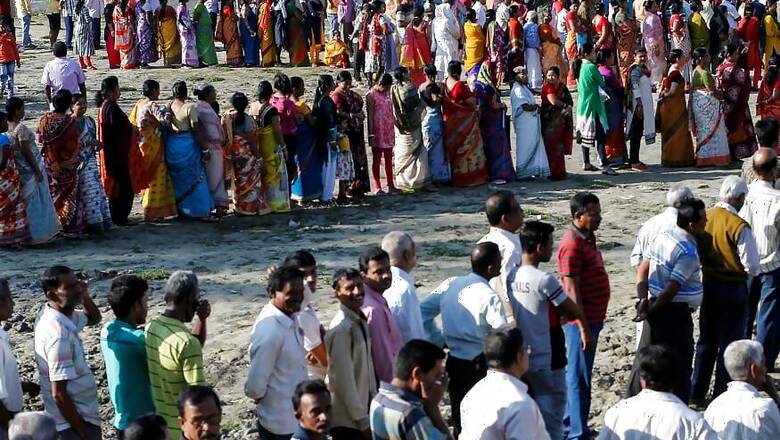
views
New Delhi: As 117 constituencies go to polls on Tuesday in the third phase of the 2019 Lok Sabha elections, the burden of India’s malnutrition hasn’t made it to the top priorities of any political parties this election season. A recent analysis by Harvard University revealed that Karnataka’s Gulbarga constituency is among the worst-hit high-profile constituencies. Incidentally, senior Congress leader Shashi Tharoor’s parliamentary constituency Thiruvananthapuram, which is also going to polls in phase three, is among the better performing lok Sabha seats.
According to IndiaSpend’s Constituency Check, in Gulbarga, stunting in children under the age of five is 52.6 per cent, wasting is 33.7 per cent, and 43.7 per cent children are underweight. In Kerala’s Thiruvananthapuram, stunting among children under the age of five is 19.5 per cent, wasting is 13.1 per cent, and 21.6 per cent children are underweight.
A report by Suresh Tendulkar committee stated that 270 million people were below the poverty line in 2011-12—the year India’s last official poverty figures were released.
In 2018, the government launched the ‘Poshan Abhiyan’ initiative, which aims to prevent and reduce the prevalence of stunting among children from 38.4 per cent in 2015-16 to 25 per cent by 2022.
During the 2014 Lok Sabha elections, the BJP government had stated in its manifesto that it will be the “government of the poor, marginalised and those left behind”. Extreme poverty and malnutrition will be treated as a national priority, and will be addressed on mission mode, the manifesto said. In 2019, this focus seems to have shifted, with the party manifesto making just fleeting mentions of malnutrition and poverty.
In all its forms, malnutrition is one of the greatest global health challenges. Poverty amplifies the risk of, and risks from, this health condition. Also, malnutrition increases healthcare costs, reduces productivity and slows the economic growth, which can perpetuate the cycle of poverty and ill health.
India is the fourth fastest growing economy and world's second largest food producer. Yet, two interrelated but distinct issues of poverty and malnutrition prevail.
Additionally, only nine percent of Indian children get proper nutrition in the age group of 9 to 24 months, making this one of the most chronic longstanding issues of the country. According to the National Family Health Survey (NFHS)-4 (2015-16) data, stunting of children in the age group of 0-6 years declined to 38.4 per cent in 2015-16 from 48 per cent in 2004-05.
Gulbarga, one of the 28 Lok Sabha seats in Karnataka going to polls, has an electoral population of 51,055,172, of which 50.5 per cent are men, 49.4 per cent are women and 4,839 come in the other category. This constituency is reserved for candidates belonging to the Scheduled Castes and has a rural population of 65 per cent. A total of 12 candidates are contesting from here.
Of the 20 parliamentary constituencies in Kerala, Thiruvananthapuram includes a total of 13.67 lakh voters, of which 7.06 lakh are women, 6.60 are men and 34 are in the other category. 17 candidates are in the fray for this seat.
In 2014, veteran Congress MP Mallikarjun Kharge had won by a margin of 74,733 votes. With a total of 17,21,990 electors, the constituency saw a voter turnout of 57.9 per cent. BJP Leader Revunaik Belamagi came in second with a vote share of 43.35 per cent, followed by D.G. Sagar of Janata Dal (Secular) with a vote share of 1.57 per cent.
The same winning pattern of parties was witnessed in 2009 when Congress’s Mallikarjun Kharge secured the first position with a vote share of 45.46 per cent, followed by BJP’s Revunaik Belamagi and JD (S) party’s Babu Honna Naik.
Congress leader Shashi Tharoor—two-time MP of Kerala’s capital city Thiruvananthapuram —won by a margin of 15, 470 votes in 2014, followed by BJP’s Sri. O. Rajagopal who got 32.32 per cent votes.
In 2009, P. Ramachandran Nair of the Communist Party of India (CPI) came in second after Tharoor, with a vote share of 30.74 per cent and much larger margin of 99,998 votes. The third position was secured by Dr. A.N. Nadar of Bahujan Samaj Party (BSP) that got a vote share of 11.69 per cent.
Umesh Jadhav, one of the prominent Congress leaders who was groomed by Kharge recently, joined the saffron party which has fielded him against Kharge in the third phase of polls. The BJP decided to focus on Gulbarga seat to maximise its impact in five constituencies that form the Hyderabad-Karnataka region, stated the party’s poll managers.
Of these five constituencies, the BJP currently holds only two—Bidar and Koppal. The other three—Gulbarga, Raichur and Bellary —are held by Congress. As a strategic move, Prime Minister Narendra Modi kick-started his elections rallies from Kalaburagi (also known as Gulbarga) to jump in on the dissidence in Kalaburagi Congress. This seeds from Kharge promoting his son Priyank, who is currently the social welfare minister in politics.
Kharge, who has been with the Congress for the last five decades, has won nine assembly and two parliamentary seats in row.
Thiruvananthapuram, a key constituency for the Congress, has swung between the CPI and Congress an equal number of times. It has never voted for the BJP.
This year former Governor of Mizoram, Kummanam Rajasekharan, will be contesting on a BJP ticket against Tharoor in the hope that the party wins this time around following the Sabarimala row.
The third candidate in the contest between Hinduism, Hindutva and Communism is the Left front's C Diwakaran. The LDF is banking on Diwakaran’s popularity in the region. They’re also hopeful about their vote base in the coastal areas after their proactive efforts post cyclone Ockhi and rehabilitation initiatives for the fishermen folk.
On January 2, 2019, two women marked a historic day by entering the Sabarimala temple, leading to statewide protests. The protesters were Lord Ayyappa’s devotees, who are against the Supreme Court verdict of allowing women entry in to the temple, and women rights activists who were determined to uphold the SC rule.
As seen in the 2018 Karnataka state assembly elections, Modi’s rallies proved to be a catalyst in improving the BJP tally in the state from 40 to 104. The Prime Minister addressed 21 rallies, six more than the ones initially planned for him.
It remains to be seen if Modi’s presence in these states will have an impact on voters in the two constituencies.


















Comments
0 comment